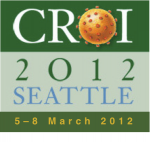Herpes Zoster vaccine safe and effective in HIV positive people
1 April 2012. Related: Conference reports, Vaccines and microbicides, CROI 19 (Retrovirus) 2012.
 Simon Collins, HIV i-Base
Simon Collins, HIV i-Base
Encouraging results were presented from the ACTG A5247 study on the use of two doses of a live varicella zoster virus (VZV) vaccine (Zostavax, Merck) in almost 400 HIV positive people who were VZV positive or who had herpes zoster (HZ)/shingles outbreak at least one year before study entry, and who were virally suppressed on stable ART. [1]
The incidence and severity of HZ and post herpatic neuralgia (PHN) is higher in HIV positive people and early use of early acyclovir treatment is not always effective. As susceptibility to HZ increases with reduced age-related immune function, a protective vaccine response already demonstrated in HIV negative people > 60 years [2] would be particularly important for HIV positive people.
Participants from over 40 US sites were randomised 3:1 to active or placebo arms and stratified by CD4 count at screening: >350 (high) vs 200-349 (low) cells/mm3. Vaccinations were given on day 0 and at week 6, with immune responses evaluated at weeks 2, 6, 8, 12, and 24.
Primary endpoints were safety (if ≤18 patients in the active arm had primary safety endpoints) and efficacy (change in VZV gpELISA titer at 6 weeks post each vaccination).
Baseline characteristics included: 84% male; 66% white, 31% black, 22% Hispanic; median age 49 years. Median CD4 count and CD4 nadir in the high (n=203) and low (n=192) groups was 602 (nadir 276) and 283 (nadir 106) cells/mm3 respectively. Almost all participant had a previous AIDS event (>97%) with 75 having prior VZV and 33% HZ > 1 year prior to entry.
In the safety analysis, there were no significant differences between the active and placebo groups and none of the 15 primary endpoints in the active arm were vaccine related. Injection site reactions were seen more frequently in the active group (42% vs 12 %, p<0.001). VZV-like rashes were seen in 3 active and 2 placebo patients with PCR showing negative or non-vaccine-strain results.
Geometric mean fold-rise in VZV antibody titre increased by 1.75 ZV vs 1.09 placebo from baseline to week 6 (p<0.001) and this remained similar at week 12 (indicating no change from the second dose). Patients with higher CD4 count at baseline had slightly higher antibody titer over time (p=0.024).
These responses were similar to those seen in HIV negative patients > 60 years. However this study was not powered to detect difference in HZ outcome and post-study follow up is not planned.
References:
- Benson C et al. Zostavax is generally safe and immunogenic in HIV+ adults virologically suppressed on ART: results of a Phase 2, randomized, double-blind, placebo-controlled trial. 19th CROI, 5–8 March 2012, Seattle. Oral abstract 96.
http://www.retroconference.org/2012b/Abstracts/44084.htm - Oxman MN et al. A vaccine to prevent herpes zoster and postherpetic neuralgia in older adults. NEJM 2005; 352:2271-8.
http://www.nejm.org/doi/full/10.1056/NEJMoa051016

